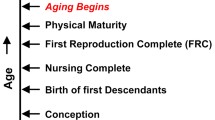Abstract
In the late seventies, a small tribal population of Paraguay, the Ache, living under natural conditions, was studied. Data from this population turn out to be useful for considerations about evolutionary hypotheses on the aging phenomenon. 1) Ache show an age-related increasing mortality, which strongly limits the mean duration of life, as observed in other studies on mammal and bird species. 2) According to current theories on aging, in the wild very few or no individual reach old age and, so, aging cannot be directly influenced by natural selection. However, data from our population show that a significant proportion of the population reaches in the wild 60 and 70 years of age. 3) Data from Ache are also in agreement with the observation about an inverse correlation between extrinsic mortality and deaths due to the age-related increasing mortality. 4) For many gerontologists, the age-related decline of vital functions is a consequence of the gradual decline of cell turnover, genetically determined and regulated by the declining duplication capacities of stem cells. The current interpretation is that these restrictions are a general defense against the proliferation of any tumoral mass. However, among wild Ache cancer is virtually unknown in non-elderly subjects, and only among older individuals are there deaths attributable to oncological diseases. Moreover, fitness decline begins long before oncological diseases have fatal effects in significant numbers. This completely disproves the current hypothesis, because a supposed defense against a deadly disease cannot exterminate a population before the disease begins to kill. These data are consistent with similar data from other species studied under natural conditions, and they bring new arguments against the non-adaptive interpretation of aging and in support of the adaptive interpretation.
Similar content being viewed by others
References
Hill, K., and Hurtado, A. M. (1996) Ache Life History, Aldine De Gruyter, New York.
Howell, N. (1979) Demography of the Dobe !Kung, Academic Press, New York.
Melancon, T. (1982) Marriage and Reproduction among the Yanomamo Indians of Venezuela: Ph. D. Dissertation, Pennsylvania State University.
Early, J., and Peters, J. (1990) The Population Dynamics of the Mucajai Yanomamo, Academic Press, New York.
Libertini, G. (1988) J. Theor. Biol., 132, 145–162.
Medawar, P. B. (1952) An Unsolved Problem in Biology, H. K. Lewis, London; reprinted in: Medawar, P. B. (1957) The Uniqueness of the Individual, Methuen, London.
Hamilton, W. D. (1966) J. Theor. Biol., 12, 12–45.
Edney, E. B., and Gill, R. W. (1968) Nature, 220, 281–282.
Mueller, L. D. (1987) Proc. Natl. Acad. Sci. USA, 84, 1974–1977.
Partridge, L., and Barton, N. H. (1993) Nature, 362, 305–311.
Williams, G. C. (1957) Evolution, 11, 398–411.
Rose, M. R. (1991) Evolutionary Biology of Aging, Oxford University Press, New York.
Kirkwood, T. B. L. (1977) Nature, 270, 301–304.
Kirkwood, T. B. L., and Holliday, R. (1979) Proc. R. Soc. Lond. B. Biol. Sci., 205, 531–546.
Kirkwood, T. B. L., and Austad, S. N. (2000) Nature, 408, 233–238.
Ricklefs, R. E. (1998) Am. Nat., 152, 24–44.
Libertini, G. (2008) TheScientificWorldJOURNAL, 8, 182–193.
Skulachev, V. P. (1997) Biochemistry (Moscow), 62, 1191–1195.
Skulachev, V. P. (1999) Biochemistry (Moscow), 64, 1418–1426.
Price, W. A. (1939) Nutrition and Physical Degeneration, Paul B. Hoeber, New York-London.
Libertini, G. (2006) TheScientificWorldJOURNAL, 6, 1086–1108.
Libertini, G. (2009) in Telomeres: Function, Shortening and Lengthening, Nova Science Publishers Inc., New York.
Fossel, M. B. (2004) Cells, Aging and Human Disease, Oxford University Press, New York.
Campisi, J. (1997) Eur. J. Cancer, 33, 703–709.
Campisi, J. (2000) In vivo, 14, 183–188.
Wright, W. E., and Shay, J. W. (2005) J. Am. Geriatr. Soc., 53, S292–294.
General Register Office for Scotland 2010, Deaths Time Series Data, Deaths in Scotland in 2009.
Northern Ireland Statistics and Research Agency, Registrar General Annual Report 2010.
Office for National Statistics, Mortality Statistics: Deaths Registered in 2009, England and Wales 2010.
Additional information
Published in Russian in Biokhimiya, 2013, Vol. 78, No. 9, pp. 1306–1317.
Rights and permissions
About this article
Cite this article
Libertini, G. Evidence for aging theories from the study of a hunter—gatherer people (Ache of Paraguay). Biochemistry Moscow 78, 1023–1032 (2013). https://doi.org/10.1134/S0006297913090083
Received:
Published:
Issue Date:
DOI: https://doi.org/10.1134/S0006297913090083




